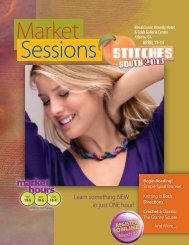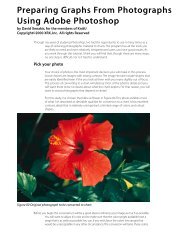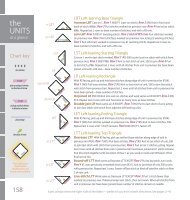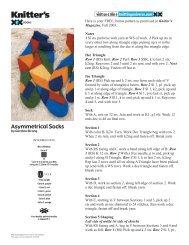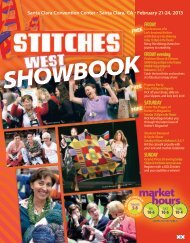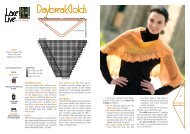Double Needle Cast-On - Knitting Universe
Double Needle Cast-On - Knitting Universe
Double Needle Cast-On - Knitting Universe
- No tags were found...
You also want an ePaper? Increase the reach of your titles
YUMPU automatically turns print PDFs into web optimized ePapers that Google loves.
<strong>Double</strong>-<strong>Needle</strong> <strong>Cast</strong>-<strong>On</strong>*<br />
Ihave saved the most difficult, but in many<br />
ways one of the most interesting of this<br />
family for last. Here is a variation that creates a<br />
handsome, unobtrusive, fully expandable edge<br />
suitable for every stitch pattern I’ve tried it on.<br />
This one is the hands-down winner. For one<br />
thing, it works beautifully with <strong>Double</strong> Rib, for<br />
which none of the other variations on Half-<br />
Hitch is quite as good. But most important, it<br />
handles a scalloped or serrated edge with<br />
aplomb. Let us consider for a moment why<br />
this is a breakthrough.<br />
Whenever one knits a pattern that creates a<br />
scalloped or angular edge – and there are<br />
many lovely patterns that do – the baseline<br />
tends to be too tight, causing the edge to curl<br />
-- and this curling cannot be steamed out.<br />
You know what it looks like – little "cups" all<br />
along the edge. Why does this happen If you<br />
were to measure along every curve or angle<br />
of an edge like that, and compare the<br />
measurement to that of the straight width of<br />
the fabric, you would find an enormous<br />
difference – the edge can sometimes be twice<br />
as long as the fabric is wide. There simply<br />
aren’t enough stitches, and therefore yarn,<br />
along the <strong>Cast</strong>-<strong>On</strong> edge to stretch that far.<br />
With <strong>Double</strong>-<strong>Needle</strong> <strong>Cast</strong>-<strong>On</strong>, additional yarn<br />
is provided to the edge, allowing it to<br />
accommodate itself to any contour the stitch<br />
pattern creates. Despite its ability to expand,<br />
the edge will be neat and trim and will neither<br />
stretch out of shape nor sag.<br />
You will remember from the discussion of Knit<br />
Half-Hitch <strong>Cast</strong>-<strong>On</strong> that the elasticity of the<br />
edge is determined by the half-hitches that<br />
encircle the base of each stitch. The trick here<br />
is to form the stitch on one needle and the<br />
half-hitch on another, smaller needle. This<br />
second needle, which should be a minimum of<br />
two sizes smaller than the top needle, acts as a<br />
gauge, measuring out a precise amount of<br />
yarn to the baseline of each stitch, thus<br />
assuring adequate yarn for expandability. The<br />
instructions will seem complicated at first, but<br />
keep in mind that you already know this <strong>Cast</strong>-<br />
<strong>On</strong> – it is simply modified. Don’t learn it just by<br />
rote, but watch carefully as you go and make<br />
sense of the process so you really understand<br />
it. With practice the technique goes smoothly,<br />
although it is impossible to do it as fast as one<br />
can do Half-Hitch <strong>Cast</strong>-<strong>On</strong>.<br />
Here are the instructions – they are long, but<br />
remember, it’s worth it:<br />
1. Allow for a tail of yarn, make a Slip Knot and<br />
place it on the needle held in the right hand,<br />
with the tail of yarn hanging down on the<br />
nearside.<br />
2. Take up a second, smaller needle and line it<br />
up under the first one, holding the two<br />
needles as one. The Slip Knot will be on the<br />
larger needle; the two strands of yarn should<br />
be hanging down on either side of the<br />
smaller one.<br />
3. Pick up the two strands of yarn in your left<br />
hand as for Knit Half-Hitch <strong>Cast</strong>-<strong>On</strong>.<br />
4. With the tips of both needles, pick up the<br />
yarn on the outside of the thumb as for Half-<br />
Hitch <strong>Cast</strong>-on.<br />
5. Pick up the strand passing from forefinger to<br />
needle with just the top needle, going over,<br />
(the strand will pass between the two<br />
needles from farside to nearside), down the<br />
farside, and under the strand.<br />
* Excerpt from The Principles of <strong>Knitting</strong>, pp. 132-134, Copyright © 1988 June Hemmons Hiatt<br />
2



